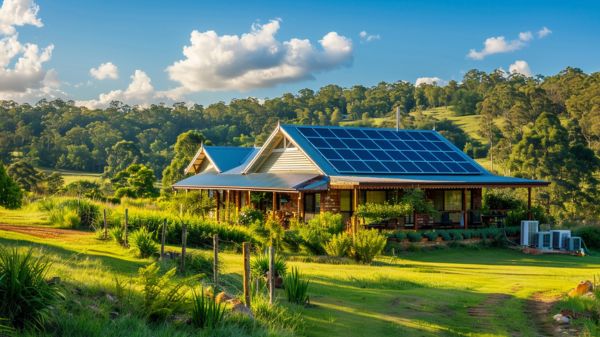Off-grid solar power systems for homes are increasingly becoming a viable solution for those seeking energy autonomy, particularly in remote areas without reliable grid access. These systems not only provide continuous power during emergencies but also contribute to a sustainable lifestyle by reducing carbon footprints.
However, the higher initial investment, primarily due to the cost of battery storage, often raises questions about feasibility and long-term benefits. Understanding the intricacies of off-grid systems, including their components, installation requirements, and maintenance needs, is important for making an informed decision.
What factors should homeowners consider to guarantee a successful shift to off-grid living? Keep on reading, as we’ll be discussing them in more details in the following paragraphs.
Benefits of Off-Grid Solar
Off-grid solar power systems for homes offer a multitude of benefits, particularly in providing energy independence and ensuring continuous home operation during grid shutdowns and emergencies. These systems liberate homeowners from the unpredictability of external utility companies by enabling a self-sustaining power supply.
The primary advantage of off-grid solar systems lies in their ability to deliver an uninterrupted power supply. During unforeseen circumstances such as natural disasters or utility grid failures, these systems guarantee that essential home functions remain operational. Data indicates that homes equipped with off-grid solar systems experience fewer power disruptions, enhancing overall reliability and peace of mind for residents.
Additionally, off-grid solar systems play a significant role in reducing the carbon footprint. By harnessing clean, renewable energy from the sun, homeowners can decrease their dependency on fossil fuels, thereby promoting environmental sustainability. This shift not only supports global efforts to combat climate change but also aligns with the growing consumer demand for eco-friendly energy solutions.
Furthermore, off-grid solar systems provide substantial long-term financial benefits. By eliminating monthly utility bills and minimizing maintenance costs, homeowners can achieve considerable savings over time. This financial autonomy, combined with energy independence, empowers individuals to take control of their energy consumption and future-proof their homes against energy market volatility.
Off-Grid Vs. On-Grid Systems
Examining the distinctions between off-grid and on-grid solar power systems elucidates their respective advantages and suitability for different energy needs. Off-grid systems provide unparalleled energy independence by operating autonomously from the utility grid, making them ideal for remote locations where grid access is impractical or nonexistent. However, Off-Grid Solar Systems Cost is generally higher due to the necessity of battery storage solutions to manage energy supply during non-sunny periods.
On the other hand, on-grid systems are integrated with the utility grid, allowing users to sell excess energy back to the grid, thereby reducing electric bills. This grid connection also serves as a reliable backup, ensuring a consistent power supply. While on-grid systems may not initially require battery storage, their dependency on the utility grid can limit their appeal to those seeking complete energy autonomy.
Both off-grid and on-grid systems benefit from a 30% Federal Tax Credit on the total system cost, which can offset initial investment expenses to a significant extent. Ultimately, the choice between these systems hinges on individual energy requirements, the desire for independence from the grid, and the feasibility of grid access.
Related Post: 5 Best Government Solar Incentives for Homeowners Explained.
Ideal Candidates for Off-Grid
Homes located in remote areas without reliable access to the utility grid are prime candidates for off-grid solar power systems. These systems offer a robust solution for homeowners seeking energy independence and self-sustainability, guaranteeing a continuous power supply regardless of grid connectivity.
The following scenarios represent ideal candidates for off-grid solar power systems:
- Remote Locations: Properties far from the reach of conventional utility grids can leverage off-grid solar systems to achieve self-sufficiency.
- Energy Independence: Homeowners desiring autonomy from utility companies and fluctuating energy prices can benefit greatly from off-grid solutions.
- Environmental Consciousness: Individuals aiming to reduce their carbon footprint and contribute to environmental sustainability will find off-grid systems highly advantageous.
- Unreliable Grid Connections: Homes in areas with frequent power outages or unstable grid connections can maintain consistent power by switching to off-grid systems.
Off-grid solar power systems empower homeowners to achieve a liberated lifestyle, free from the constraints of grid dependency. These systems are particularly advantageous in scenarios where grid access is impractical or unreliable, providing an effective means to harness renewable energy directly.
Costs of Off-Grid Systems
The investment required for an off-grid solar power system can vary greatly, typically ranging from $20,000 to over $100,000, depending on the system’s size and complexity. This variation in system costs is primarily driven by the components involved, including solar panels, batteries, inverters, charge controllers, and any additional alternative energy sources.
Labor expenses, constituting roughly 10% of the total installation cost, average around $0.59 per watt, further influencing the financial outlay.
A thorough understanding of these cost components is essential for effective planning. For instance, high-capacity batteries and advanced charge controllers can considerably elevate the initial investment but are critical for ensuring consistent power supply, especially in areas with limited sunlight. Similarly, premium-grade solar panels contribute to higher upfront costs but offer long-term efficiency gains.
The Federal Tax Credit, offering up to a 30% deduction on installation expenses, plays a pivotal role in mitigating these costs. This financial incentive not only reduces the initial economic burden but also accelerates the return on investment, making off-grid solar systems a more viable option for those seeking energy independence.
Solar Panel Options
Exploring solar panel options for off-grid systems involves evaluating monocrystalline, polycrystalline, and thin-film panels based on their efficiency, performance, and installation suitability.
Monocrystalline panels offer high efficiency and compact size, making them ideal for limited spaces, while polycrystalline panels provide a more budget-friendly alternative with slightly reduced efficiency.
Thin-film panels, known for their lightweight and flexible characteristics, are advantageous for non-traditional installation sites, emphasizing the importance of matching panel type to specific energy needs, space constraints, and financial considerations.
Types of Solar Panels
Several types of solar panels are available, each offering unique advantages tailored to specific needs and applications. These options are essential for those considering Off-Grid Solar systems to maximize energy independence and efficiency.
The main types of solar panels include:
- Monocrystalline Solar Panels: Known for their high efficiency and longevity, these panels are ideal for maximizing energy output in limited space.
- Polycrystalline Solar Panels: Cost-effective and widely available, they provide a balanced option for those looking to achieve a good return on investment without compromising too much on performance.
- Thin-Film Solar Panels: Lightweight and flexible, these panels are suitable for various installations, including unconventional spaces where traditional panels may not fit.
- Bifacial Solar Panels: Capable of generating energy from both sides, these panels increase overall efficiency, making them an excellent choice for environments with reflective surfaces.
Choosing the right type of solar panel for an Off-Grid Solar system is paramount. Each type has specific attributes that cater to different installation environments and energy requirements. Monocrystalline panels, with their high efficiency, are perfect for areas with limited roof space, while polycrystalline panels offer a cost-effective solution. Thin-film panels provide flexibility and adaptability, and bifacial panels enhance energy capture, especially in reflective settings.
Efficiency and Performance
Understanding the efficiency and performance of different solar panel options is essential for optimizing the energy output and overall effectiveness of an Off-Grid Solar Power System. Solar panel efficiency levels typically range from 15% to 22%, directly impacting the amount of electricity generated per square meter. Higher efficiency levels are particularly beneficial when space is limited, allowing for more power generation from a smaller array.
Monocrystalline panels stand out due to their high efficiency and sleek appearance, often achieving efficiency levels up to 22%. Their superior performance makes them ideal for homeowners seeking maximum energy output and long-term reliability. These panels are constructed from a single crystal structure, which enhances electron mobility and contributes to their high efficiency.
Polycrystalline panels, although slightly less efficient, offer a cost-effective alternative, making them a practical choice for those looking to balance performance with budget considerations. They typically achieve efficiency levels between 15% and 17%.
Thin-film panels, on the other hand, provide unique advantages such as being lightweight and flexible, which can be advantageous for specific installation scenarios. While their efficiency levels are generally lower, typically around 10% to 12%, their versatility and ease of installation can be liberating for innovative and custom off-grid solutions.
Installation Considerations
When planning the installation of an off-grid solar power system, selecting the appropriate solar panel type is essential to achieving peak energy production and long-term reliability. The choice of solar panels greatly impacts system efficiency and cost-effectiveness, tailored to meet specific energy needs and environmental conditions.
Key considerations for selecting the right solar panel type include:
- Panel Efficiency: This determines how much sunlight is converted into usable energy. Monocrystalline panels, known for their high efficiency and durability, are often preferred for off-grid systems.
- Cost and Budget: Polycrystalline panels offer a cost-effective alternative with slightly lower efficiency, making them suitable for budget-conscious installations.
- Physical Constraints: Thin-film panels, being lightweight and flexible, are ideal for unconventional installations where traditional rigid panels are impractical.
- Wattage and Size: The total energy production capability depends on the wattage and size of the panels, which should align with the household’s energy consumption patterns.
Battery Choices
Selecting the right battery for an off-grid solar power system involves evaluating factors such as cost, energy density, lifespan, and maintenance requirements.
Among the various battery choices available, lead-acid batteries remain a staple due to their affordability and long-standing reliability. These batteries, particularly in deep-cycle formats, are designed to endure repeated discharging and recharging cycles, making them an established option for off-grid applications.
However, the landscape is shifting with the rising popularity of lithium-ion batteries. These batteries offer notably higher energy density and a longer lifespan compared to lead-acid batteries. This results in more energy storage in a smaller footprint and reduced frequency of replacements, albeit at a higher upfront cost.
For those seeking a maintenance-free solution, AGM (Absorbent Glass Mat) batteries present an attractive proposition. These are spill-proof and require no water refilling, offering convenience without compromising on performance.
Battery capacity, measured in kilowatt-hours (kWh), is a critical parameter that dictates how much energy can be stored and utilized. Properly sizing the battery bank to match energy consumption needs ensures a seamless and reliable off-grid experience, ultimately empowering users with energy independence and sustainability.
Building an Off-Grid System
Constructing an off-grid solar power system demands meticulous selection of key components such as solar panels, batteries, charge controllers, and inverters to guarantee efficient energy production and storage.
The installation process involves strategic planning and precise execution to secure continuous power supply and system reliability. Proper consideration of these factors will result in a sustainable and independent energy solution for homeowners.
Essential Components Required
An effective off-grid solar power system for homes is built upon four essential components: solar panels, batteries, a charge controller, and an inverter. These components work synergistically to provide a reliable and sustainable power solution, guaranteeing independence from the traditional electricity grid.
- Solar Panels: These are the heart of off-grid solar systems, converting sunlight into direct current (DC) electricity. The choice of solar panels must be driven by efficiency ratings and durability.
- Batteries: Critical for storing energy, batteries ensure that power is available during nighttime or cloudy periods. Lithium-ion and lead-acid batteries are the most common types used.
- Charge Controller: This device regulates the voltage and current coming from the solar panels, preventing battery overcharging and prolonging battery life. Maximum Power Point Tracking (MPPT) controllers are highly recommended for their efficiency.
- Inverter: Converts the stored DC power into alternating current (AC) power, which is used by most household appliances. Pure sine wave inverters are preferred for their efficiency and compatibility with sensitive electronics.
Each of these essential components plays a pivotal role in the generation, storage, and conversion of energy, ensuring a continuous and efficient power supply. Understanding and integrating these components is fundamental to achieving true energy liberation with off-grid solar systems.
Installation Process Steps
How does one effectively approach the installation process of an off-grid solar power system to guarantee peak performance and longevity? The journey begins with a thorough site assessment to determine the best sun exposure and the ideal placement of solar panels.
This critical step guarantees maximum energy capture and system efficiency. Following this, we must execute the installation of key components—solar panels, batteries, charge controller, and inverter—according to a precise system design.
| Step | Description |
|---|---|
| Site Assessment | Evaluate sun exposure and best placement for panels. |
| Component Installation | Install solar panels, batteries, charge controller, and inverter. |
| Wiring | Connect components to ensure smooth energy flow. |
| Testing and Commissioning | Verify system operation and efficiency. |
| Regular Maintenance | Monitor and maintain to ensure long-term performance. |
Wiring the components together is the next critical phase, ensuring that all parts work harmoniously for smooth energy flow and functionality. Once you wired the system, thorough testing and commissioning are imperative to confirm that the off-grid system operates correctly and efficiently.
Finally, regular maintenance and monitoring are essential to maximize the performance and longevity of the system, liberating homeowners from the constraints of traditional energy sources. This structured approach to off-grid solar system installation not only guarantees peak performance but also ensures sustainability and self-reliance.
System Components
A typical off-grid solar power system for homes comprises several critical components:
- Solar Panels: The backbone of solar panel systems, these photovoltaic modules capture sunlight and convert it into direct current (DC) electricity.
- Batteries: Essential for energy storage, batteries hold excess power generated by the solar panels. We can use this stored energy during periods without sunlight, ensuring a continuous power supply.
- Charge Controller: This device regulates the flow of electricity from the solar panels to the batteries, preventing overcharging and enhancing the longevity of the battery system.
- Inverter: The inverter converts DC electricity from the solar panels and batteries into alternating current (AC) electricity, which is compatible with standard household appliances.
Installation Considerations
Effective installation of off-grid solar power systems for homes requires meticulous consideration of site-specific factors such as location, shading, roof orientation, and available sunlight to optimize solar panel performance. Evaluating these parameters guarantees that the system captures maximum solar energy, which is vital for an efficient off-grid setup.
Key installation considerations include the proper sizing of both the solar array and the battery bank to meet the home’s energy demands. Over- or under-sizing these components can lead to inefficiencies, ultimately impacting energy reliability and independence. Additionally, carefully selecting and positioning system components like inverters, charge controllers, and batteries is crucial for seamless integration and efficient functionality.
Financial aspects also play a significant role. Installation costs encompass labor, permits, equipment, and potential upgrades to the existing infrastructure to support the off-grid solar system. We highly recommend professional installation to ensure safety, regulatory compliance, and maximized energy production.
Experts can navigate the complexities of local regulations and technical requirements, providing homeowners with a solution-focused path to energy autonomy.
Maintenance Tips
Regular maintenance of off-grid solar power systems for homes is essential for ensuring peak performance and longevity. By adhering to a few critical maintenance tips, homeowners can optimize energy production and guarantee reliable energy storage, thereby achieving the highest efficiency from their systems.
- Clean Solar Panels Regularly: Dust, dirt, and debris can greatly reduce the efficiency of solar panels. Regular cleaning helps maintain peak energy production levels.
- Maintain Battery Health: Batteries are the backbone of reliable energy storage. Regular checks and maintenance, such as monitoring charge levels and electrolyte levels in lead-acid batteries, are vital.
- Inspect Electrical Connections: Loose or corroded connections can lead to system failures. Periodically inspect and tighten these connections to ensure the system operates smoothly.
- Trim Surrounding Vegetation: Overgrown trees and plants can cast shadows on the solar panels, reducing their efficiency. Regularly trim vegetation to prevent shading.
In addition to these preventative measures, scheduling professional inspections can provide in-depth system maintenance and troubleshooting. This holistic approach to maintenance not only prolongs the system’s lifespan but also supports the homeowner’s quest for energy independence and sustainability.
Conclusion
Off-grid solar power systems for homes offer significant advantages, such as energy independence, uninterrupted power supply during emergencies, and a reduction in carbon footprint. Despite the higher initial investment, particularly in battery storage, these systems provide long-term financial savings and sustainability.
Ideal for remote locations, off-grid solar systems enable homeowners to generate reliable, eco-friendly power. Proper component selection, meticulous installation, and regular maintenance are essential for maximizing efficiency and lifespan of the system.




